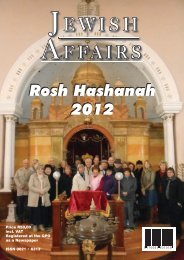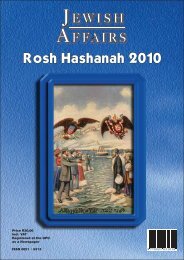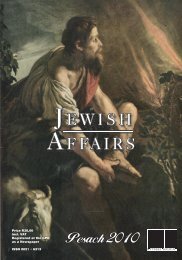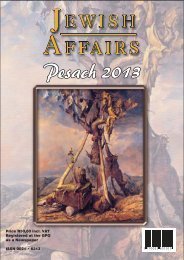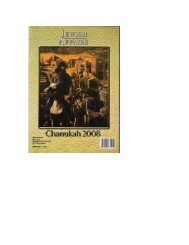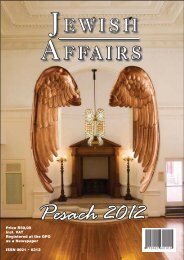Rosh Hashanah 2009 - South African Jewish Board of Deputies
Rosh Hashanah 2009 - South African Jewish Board of Deputies
Rosh Hashanah 2009 - South African Jewish Board of Deputies
- No tags were found...
You also want an ePaper? Increase the reach of your titles
YUMPU automatically turns print PDFs into web optimized ePapers that Google loves.
JEWISH AFFAIRS ROSH HASHANAH <strong>2009</strong><strong>of</strong> the city”. 74 The ghetto was situated in the areaaround what is today Piazza della Repubblica and aplaque in this piazza reads “The old centre <strong>of</strong> the citywas restored to new life after centuries <strong>of</strong> squalor”.The Florence Synagogue (which is Sephardi) isone <strong>of</strong> the most beautiful in Europe. Money wasdonated by David Levi to build a synagogue “worthy<strong>of</strong> Florence”. It was completed in 1882, and is <strong>of</strong>Moorish design. Its central dome is sheathed incopper, which has since turned green. The doors <strong>of</strong>the ark still bear the scars inflicted by Fascist bayonets.Unlike in Rome, the <strong>Jewish</strong> community in Florencedecided to locate the synagogue away from the areawhere the ghetto existed. The synagogue has aninteresting <strong>South</strong> <strong>African</strong> connection. In 1944,servicemen Leon Dison and Hymie Bloch wereinstructed to check the building as it was feared thatit had been booby trapped by the Nazis. Bloch livedin Durban and passed away in 2004. As <strong>of</strong> last yearLeon Dison, aged 87, was living in Johannesburg. 75Michelangelo’s David is housed in the AccademiaGallery. Given that Michelangelo was supposedly sowell versed in Judaism, it is an interesting question asto why David is uncircumcised. The Sistene Secretsclaims that the simplest reason is that Michelangelohad never seen a circumcised organ. The other reasonit puts forward is that the Inquisition was still strongand Michelangelo did not want to be accused <strong>of</strong>Judaizing. 76The Church <strong>of</strong> Santa Croce displays a prominentMagen David on its exterior. The façade was designedby a <strong>Jewish</strong> architect who, according to the TheSistine Secrets, was told that his name would notappear on the church, so insisted that a large MagenDavid be placed prominently on its front. 77 Jewswere forced to fulfil quotas to listen to sermons in thischurch, with the preacher’s fee having to be paid bythe <strong>Jewish</strong> community. 78The <strong>Jewish</strong> community <strong>of</strong> Florence todaynumbers around 900.VeniceVenice was for a long time intolerant <strong>of</strong> Jews,who were considered dangerous rivals in trade, butthis was more from commercial jealousy thanreligious zeal. No concrete pro<strong>of</strong> <strong>of</strong> a <strong>Jewish</strong> presencein Venice can be traced prior to the 14 th Century,although many <strong>Jewish</strong> merchants and moneylendersvisited and worked in the city from the 10 th Centuryonwards. In 1298, the rate <strong>of</strong> interest charged by thelocal Christian usurers had become so severe that<strong>Jewish</strong> moneylenders were permitted. The prejudicewas so strong, however, that initially Jews had toconduct business from Mestre, the nearest point onthe mainland. In the end, three loan banks werepermitted to open in the city. 79 A condotta, whichregulated this arrangement, was periodically renewedand at times cancelled.Over time, the number and importance <strong>of</strong> theJews increased. In 1516, agitation for the expulsion<strong>of</strong> the Jews ultimately led to a decision to segregatethe entire community. The place which was chosenwas where a cannon foundry had been present.Venice was the first city in the world to force Jews tolive in a ghetto and indeed is the city that gave theworld that word. The word ghetto most probablyderives from the Italian word geto, which meansfoundry. 80 The ghetto had high walls and two gatesmanned by four Christian guards, six other guardsmanned two patrol boats to prevent nocturnalviolations, and all ten had to be paid by the <strong>Jewish</strong>community. Although ostracized, Jews were safe inVenice. In the 17 th Century, its golden age, 5000Jews lived in the ghetto. <strong>Jewish</strong> scholarship andcommerce flourished, with Jews controlling most <strong>of</strong>Venice’s foreign trade. According to a <strong>Jewish</strong> writerin the 17 th century, the Venetians were “more pleasingand kindly with the Jews than any other in theworld”. 81 Rabbis frequently complained about theluxury and worldliness <strong>of</strong> ghetto life, and thepreference for Italian over Hebrew. Many <strong>of</strong> themwould have liked the ghetto walls to be higher. 82 TheVenice ghetto was a relatively large quarter, and isone <strong>of</strong> the few that have survived in their originalform.The birth <strong>of</strong> Hebrew publishing in Venice tookplace contemporaneously with the birth <strong>of</strong> the ghetto.Hebrew publishing was important for its quantityand especially the quality <strong>of</strong> its output. 83 The gates <strong>of</strong>the ghetto were pulled down after the Napoleonicinvasion in 1797.There are five synagogues in the ghetto, twoAshkenazi (for German, and French Jews), one forItalian rites and two Sephardi (for Spanish and TurkishJews). These all date back to the 16 th Century. Onlytwo are still actively used, the Spanish synagoguebetween Pesach and <strong>Rosh</strong> <strong>Hashanah</strong>, as it is cool,and the Turkish synagogue between <strong>Rosh</strong> <strong>Hashanah</strong>and Pesach, as it has heating. The Spanish synagoguehas been described as the most immense and imposing<strong>of</strong> the Venetian synagogues 84 and may be the onlysynagogue in the world that has held servicescontinuously from 1550 to the present day. 85Shabbat meals are available at the Gam Gamrestaurant, which is hosted by Chabad Rabbi SchacharBanin and his wife Ramy. Rabbi Banin was born inItaly <strong>of</strong> Yemenite extraction and has been living inVenice for seventeen years.The Rialto commercial district was the setting forShakespeare’s The Merchant <strong>of</strong> Venice, and itdepended on <strong>Jewish</strong> merchants and moneylenders.Paul Johnson, in his History <strong>of</strong> the Jews, writes thatit was plausible in having Jessica say that her fatherShylock’s house was full <strong>of</strong> treasures. Successful<strong>Jewish</strong> moneylenders <strong>of</strong>ten accumulated quantities<strong>of</strong> unredeemed pledges, especially jewels. 86The <strong>Jewish</strong> population <strong>of</strong> Venice is less than 500,and <strong>of</strong> these, very few live in the ghetto.NOTES1 Roth, Cecil, The History <strong>of</strong> the Jews <strong>of</strong> Italy, The <strong>Jewish</strong>Publication Society <strong>of</strong> America, 1946, p1562 Encyclopaedia Judaica, 1972, 14:240, hereafter cited as“EJ”43



